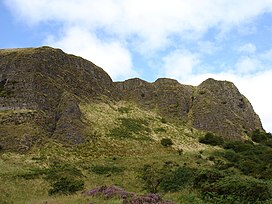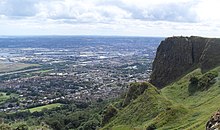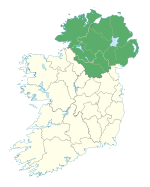Cavehill
| Cave Hill | |
|---|---|
| Binn Uamha | |
 | |
| Highest point | |
| Elevation | 368 m (1,207 ft) |
| Coordinates | 54°38′49″N5°57′04″W/ 54.647°N 5.951°W |
| Geography | |
| Location | nearBelfast,County Antrim,Northern Ireland |
| Climbing | |
| Easiest route | Hike |
Cave HillorCavehill[1]is a rocky hill overlooking the city ofBelfast,Northern Ireland,with a height of 368 metres (1,207 ft). It is marked bybasaltcliffs and caves, and its distinguishing feature is 'Napoleon's Nose',[2]a tall cliff resembling the profile of the emperorNapoleon.On top of this are the remains of an ancientpromontory fortcalled McArt's Fort. Cavehill was also historically called 'Ben Madigan' (fromIrish:Beann Mhadagáin,"Madagán’s peak" ), after a king ofUlstercalled Madagán.[1]
It forms part of the Belfast Hills and marks the southeastern edge of theAntrim Plateau.All of Belfast can be seen from its peak, as can theIsle of Manand Scotland on clear days. LikeArthur's Seatin Edinburgh, it lies just a few miles from the centre of a major city.
Cave Hill is thought to be the inspiration forJonathan Swift'sGulliver's Travels.Swift imagined that Cave Hill resembled the shape of asleeping giantsafeguarding the city.[3]
Overview
[edit]Cave Hill rises to 368 metres (1,207 ft) above sea level. Most of its lower east side lies on theBelfast Castleestate, which has as its focal point the imposing 19th-centuryScottish baronialcastle. The castle was designed by the firm ofLanyon, Lynn and Lanyonand was constructed forThe 3rd Marquess of Donegallin the late 1860s and early 1870s in the Deer Park. The slopes of Cave Hill were originally used as farmland but, from the 1880s, a major planting exercise was undertaken, producing the now familiar deciduous and coniferous woodland landscape. Belfast Castle estate was given to the City of Belfast byThe 9th Earl of Shaftesburyin 1934.[citation needed]
Caves
[edit]
There are three large caves. The lowest is 21 feet (6.4 m) long, 18 feet (5.5 m) wide and varies from 7 to 10 feet (3.0 m) in height. Above this is another cave; 10 feet (3.0 m) long, 7 feet (2.1 m) wide and 6 feet (1.8 m) in height. Above this is the third major cave, said to be divided into 2 unequal parts, each of which is more extensive than the larger of the other caves, but the ascent is notoriously dangerous and thus few venture to it. The caves are man-made, and it is postulated that they were originallyexcavatedfor iron-mining.[citation needed]
Adjacent to the lowest cave is 'The Devil's Punchbowl', also sometimes called 'The Devil's Cauldron', a site where ancientCelticfarmers corralled their cattle. This consists mainly of a steep hill, mainly of rocks and boulders, and is considered dangerous to amateurs.[citation needed]
McArt's Fort
[edit]
This fort, on the top of the cliff, is an example of an oldringfortor rath. It is protected on one side by a precipice. On the others by a single ditch with a depth of 10 feet (3.0 m) and width of 25 feet (7.6 m). The enclosed area is nearly level. The flat top of the fort is 150 feet (46 m) from north to south, and 180 feet (55 m) from east to west.
It is believed that the fort's inhabitants used the caves to store food for the winter and may have served as a refuge during times of attack.[citation needed]Due to its imposing profile, the site of the fort is nicknamed 'Napoleon's Nose' by locals. More to the point if you look up to Cave Hill from many parts of Belfast you would see its profile that resembles Napoleon Bonaparte's nose from the side.
History
[edit]
The name 'Cave Hill' appears to be a translation of theIrishBinn Uamha.[1]The hill was originally known in Irish asBeann Mhadagáin(meaning "Madagán's peak" ), after a king ofUlaid(Ulster),Matudán mac Muiredaig,who died in 856 AD.[1]It could also be named after a later king,Matudán mac Áeda(reigned 937–950). The later king's grandson, Eochaid mac Ardgail, was killed at the battle of Crew Hill in 1004, in which the men of Ulster were defeated by their old enemies, theCenél nEógain.It is from him that McArt's Fort derived its name.
The residential neighbourhood at the foot of Cave Hill's entrance is derivatively known as Ben Madigan, with street names to match, and is a wealthy semi-outer city, semi-suburban area.[citation needed]The name 'Ben Madigan' can also be found attached to buildings and schools close to the area, e.g. theBelfast Royal Academyhas the Ben Madigan Preparatory School on theAntrim Road.[citation needed]
United IrishmenTheobald Wolfe ToneandHenry Joy McCrackenallegedly met at Cave Hill in 1795 to take an oath to launch therebellion of 1798.McCracken was captured on Cave Hill in 1798.
The crowning stone Giant's Chair of the O'Neill clan was apparently sited on Cave Hill summit until 1896 and gave its name to the nearby Throne Hospital.[citation needed]
DuringWorld War II,a bomb dropped prematurely during a German bombing raid on Belfast exploded, causing a large crater near the grounds of Belfast Castle. It is understood thatRAF Bomber Commandwas situated on Cave Hill in the early years of World War II before relocating toCastle ArchdaleinCounty Fermanagh.Hence the German bomb may have been intentional.[citation needed]
On 1 June 1944, an American Air Force B-17 bomber crashed into Cave Hill during heavy fog, killing all ten crew instantly. The incident inspiredRichard Attenborough's film,Closing the Ring.Some scenes of the film were shot on Cave Hill. The site of the crash is accessed via Carr's Glen Country Park where the field, known locally as 'The Bomb hole Field' remains open to public.
Geology
[edit]
The hill owes its characteristic shape toPaleocenebasalt lava flows, from 65 million years ago. This is underlain byCretaceous—145 million years—Ulster White Limestone and below this isJurassic—200 million years—Waterloo Mudstone Formation, more commonly known as Lias clay.[citation needed]
Limestone was mined on the southern flanks of Cave Hill in Victorian times and transported to Belfast docks by way of a horse-worked railway along the Limestone Road. The railroad was abandoned in the 1890s. Two small hamlets—Daddystown and Mammystown—were built on either side of the railway track in the early 1820s as dwellings for quarry workers. Some of the local avenues and streets bear the name 'Waterloo', in reference to their geological origins.
Tourism and recreation
[edit]
Cave Hill Country Park,Belfast Zooand Belfast Castle are visited by both locals and tourists. In the 18th century, the people of Belfast visited the area on Easter Monday for the Cave Hill fete, near a spring known as the 'Volunteers' Well'. The summit has views southwards over Belfast City and Lough towards theMourne Mountains,Scrabo Towerand Slieve Croob.[citation needed]
See also
[edit]References
[edit]- ^abcdNorthern Ireland Place-Names Project."Cave Hill".
- ^BBC News website
- ^"Belfast Hills".Discover Northern Ireland.Northern Ireland Tourist Board.Retrieved18 May2007.
Further reading
[edit]- Reynolds, Philip; Turner, Samuel (1902)."The Caves in Ben Madighan".Ulster Journal of Archaeology.8.Belfast: McCaw, Stevenson & Orr, Limited: 73–82.Retrieved13 August2012.







